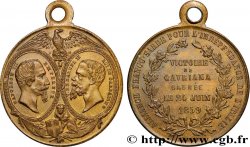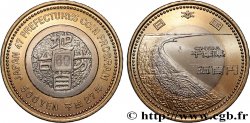得先注册又得到批准才可以报价。为了报价注册. 客户应该得到公司允许,那种过程需要 48 个小时。别等出售结束那一天才登记。您报价的话等于您赞成买那物品,而且按« 保价 » 证明您接受 cgb.fr 因特网拍卖使用法.
报价时只可以出全数值欧元总额。物品描述也说明销售结束时间,结束后出价都不会生效。 报价命令转达有时变动,等到最后秒钟增加否决的可能会。想多了解的话请注意 因特网拍卖常问
最高出价方将支付18%的不含税的拍卖费用
最高出价方将支付18%的不含税的拍卖费用
| 估算 : | 300 € |
| 价格 : | 150 € |
| 最高出价 : | 150 € |
| 拍卖结束日期 : | 10 April 2018 17:10:41 |
| 竞拍人 : | 1 竞拍人 |
种类 Médaille de l’Exposition Universelle
日期: 1855
铸币厂名称/城市 75 - Paris
材质 copper
直径 68 mm
模子方针 12 h.
硬币制模工 CAQUÉ Armand Auguste (1795-1881)
重量 166 g.
侧面 Lisse + main CUIVRE
印模 MAIN Cuivre
关于品相的说明
Présence de coups et fines rayures. Faible usure sur les points hauts
出版目录中的项代码 :
正面
正面的文字 EUGÈNIE IMPÉRATRICE. NAPOLÉON III EMPEREUR.
正面的说明书 Bustes accolés d’Eugénie et Napoléon III; signé : CAQUE. F. / GRAVEUR DE S.M.L’EMPEREUR.
背面
背面的文字 PALAIS DE L’INDUSTRIE, (LÉGENDE SUPÉRIEURE); COMMENCE 10 FÉVR : 1853. ACHEVÉ AVRIL 1855. / NAPOLÉON III EMPEREUR / A. FOULD, CTE DE PERSIGNY, MAGNE / MINISTRES. / VTE DE ROUVILLE DIRECTEUR. / ARDOIN, RICARDO, BOUISSIN ADMIN / VIEL ARCHIT: BARRAULT ING / GERVAIS ET CNE EDIT., (EN 8 LIGNES À L’EXERGUE).
背面的说明书 Vue axonométrique sur le Palais de l’industrie.
评论
Armand Auguste Caqué, né à Saintes (Charente-Inférieure) le 24 janvier 1795 et mort à Paris le 31 décembre 1881 à l'âge de 86 ans, est un sculpteur, graveur et médailleur français. Graveur officiel de l'empereur Napoléon III. Ses médailles sont signées CAQUÉ F et quelquefois sa signature est suivie de la mention "Graveur de S. M. l'Empereur".
L’exposition universelle fut décrétée pour le 15 mai 1855 pour témoigner au monde entier de la prospérité de la France, suite à l’exemple de l’Angleterre en 1851. Napoléon III inaugura cette première exposition universelle française en déclarant : “j’ouvre avec bonheur ce temple de la paix qui convie tous les peuples à la concorde”.
Le palais de l’industrie étonna par sa construction métallique et la hardiesse de la nef centrale haute de 35 mètres. Construit de 1853 à 1855, sur les plants de l’architecte Jean-Marie VIel (1797-1863), il forme un parallélogramme de fonte et de verre à deux étages, dont les façades principales ont 252 mètres de long, et les façades latérales 108 mètres. Il est composé d’un pavillon central et de pavillons d’angle. L’entrée principale se compose d’une immense arcade, flanquée de chaque côté de colonnes corinthiennes et surmontées d’une attique que décorent un bas-relief.
Le palais subsistera jusqu’en 1900 pour ensuite être démoli et remplacé par les Petit et Grand Palais actuels construits pour l’Exposition Universelle de Paris en 1900.
Source : Médailles de Napoléon III, Hess Divo.
L’exposition universelle fut décrétée pour le 15 mai 1855 pour témoigner au monde entier de la prospérité de la France, suite à l’exemple de l’Angleterre en 1851. Napoléon III inaugura cette première exposition universelle française en déclarant : “j’ouvre avec bonheur ce temple de la paix qui convie tous les peuples à la concorde”.
Le palais de l’industrie étonna par sa construction métallique et la hardiesse de la nef centrale haute de 35 mètres. Construit de 1853 à 1855, sur les plants de l’architecte Jean-Marie VIel (1797-1863), il forme un parallélogramme de fonte et de verre à deux étages, dont les façades principales ont 252 mètres de long, et les façades latérales 108 mètres. Il est composé d’un pavillon central et de pavillons d’angle. L’entrée principale se compose d’une immense arcade, flanquée de chaque côté de colonnes corinthiennes et surmontées d’une attique que décorent un bas-relief.
Le palais subsistera jusqu’en 1900 pour ensuite être démoli et remplacé par les Petit et Grand Palais actuels construits pour l’Exposition Universelle de Paris en 1900.
Source : Médailles de Napoléon III, Hess Divo.








 对产品描述纠错
对产品描述纠错 打印
打印 分享我的选择
分享我的选择 提问
提问 Consign / sell
Consign / sell
 产品介绍
产品介绍















